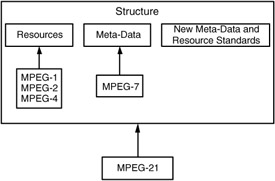3.5 Interoperable MPEG: From MPEG-1 to MPEG-21
|
| < Day Day Up > |
|
3.5 Interoperable MPEG: From MPEG-1 to MPEG-21
The MPEG group introduced ISs within MPEG-1, MPEG-2, MPEG-4, MPEG-7 and MPEG-21 (parts of MPEG-21 are still under development). These standards address different issues (see Exhibit 3.9).
Exhibit 3.9: Relationship of the Moving Picture Experts Group standards.

MPEG-1 and MPEG-2 provide interoperable ways of representing AV content. MPEG-4 extends this to many more application areas through features like extended bit-rate range, scalability, error resilience, integration of different types of objects in the same scene, interfaces to digital-rights management systems, and the integration of interactivity into content (see Chapter 1). In contrast to this, MPEG-7 defines an interoperable framework for content description. MPEG-7 has descriptive elements that range from very low level signal features like color, shape, and sound characteristics to high-level structural information about content collections (see Chapter 2).
MPEG-7 is not only a standard for the description of the content of MPEG-1, MPEG-2, and MPEG-4 encoded multimedia material but is also a coding standard for XML-based descriptions and a file format (by the use of the MPEG-7 systems tools). In particular, it employs the same time-dependent unit (AU, access units) used in the formats of MPEG-2 and MPEG-4. Thus, it is possible to reference metadata from media data or vice versa. This transferability enhances interactivity with the user to a great extent. A user may find the metadata for a media scene, similar scene descriptions may be searched (metadata search), and the appropriate media scenes may then be displayed. This requires means for synchronization of meta-and media data. Technical solutions have been found for MPEG-2 and MPEG-7, and solutions for MPEG-4 are under consideration.
The MPEG-21 multimedia framework gives the "big picture" and achieves end-to-end interoperability; that is, it offers a framework to build an infrastructure for the delivery and consumption of multimedia content. The components proposed are users that interact with DIs. A DI can be anything from an elemental piece of content, for example, a single picture or a sound track, to a complete collection of audiovisual material. Moreover, the content is not limited to existing formats. As the DI is only a container, it requires that its description be filled with existing metadata standards, for example, MPEG-7 for the description of the multimedia semantics, the media formats, and much more, to facilitate their integration in the whole distributed multimedia system.
In Chapters 4 and 5, we will detail the influence of the newest MPEG standards on distributed multimedia database technologies.
|
| < Day Day Up > |
|
EAN: 2147483647
Pages: 77